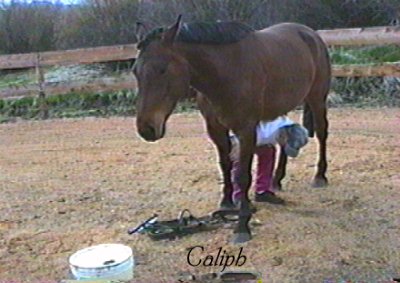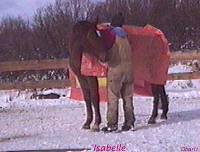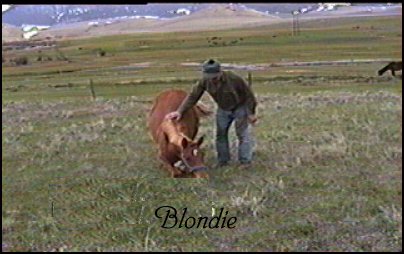
Medicine Lodge Valley, Dillon, Montana
Submission
![]()
The following 3 basics are needed before any horse can be directed in further training.
- Absolute trust in the human
- Resistance being useless
- Understand what is wanted and how to do it.
Absolute trust in the human needs to be made in order for the horse to learn willingly.

Walking under Caliphs belly
- A horseman never gets trust in a horse if the horseman breaks the spirit of the horses mind.
- The human has to figure out how the horse thinks and what it will take for the horse to willingly submit to the human.
Resistance being useless

Belle
- The horse needs to have confidence in the horseman by being convinced that the humans are kind. To a horse humans represent all good things and painful experiences are the result of resistance and bad manors. The horse needs to think that the human can have powers far greater than the horse. Powers that are psychological.
- If a horse never experiences the bad how will he know what the good is. I am referring to resistance. If a horse is not made to resist then the horse will never know that resisting is useless.
- This rule fosters the punishment as soon as the act is committed. Not even 10 seconds later.
Understand what is wanted and how to do it.

Blondie laying down
- A horseman must acknowledge that a horse does not know the humans language, nor thought patterns. As a human we need to place ourselves in there position of understanding. Going back to the alien-human sentence in the personality section. If the alien starts saying "iglubab getron eug" and you just stand there not knowing what the alien has said and the alien says it again and you stand there and all of a sudden the alien gets out his extron stick and hits you. After he hits you do you understand what he said. No.
A horse has ingrained thought patterns breed in to them, and the human is not part of the ingrained pattern. A trainer must acknowledge the horses instincts and work with them to intertwine what the human wants.
How can one get submission on anything? Either by co-operating (wanted) or by force through fear (not wanted). One must also realize that bad behavior is NOT to be treated the same as good behavior. The horse can only be rewarded for good behavior not rewarded for bad behavior.
A horse that is trying to learn and change his thought pattern will be easier to train and convince verses a horse that will not try at all to change his thought pattern. The horse that is trying will submit and further training can be done, but the horse that is not trying submit can not advance in training. His unwillingness will surface with any lesson that is trying to be taught. A horse of this thought pattern will need to be "awoken" to see the light. Different lessons will be made from the horse that is trying.

Methods of submission
Developments
- Manage the mental attitude
- Manage nervous reaction
- Manage physical reaction
Treatment
In order to do management of the horses you need to "read" the horses language. And apply one or more approaches.
- soothing
- tone of voice
- surroundings
- repetition
- touching
- Soothing a horse may be by rubbing or brushing the horse rhythmically on the neck. It has a hypnotic affect on the horse. It will sooth the horse to give it a trust fact for the human.
- Tone of voice is a very power full tool. A quite or non abrasive all the way to harsh and spiting. Of course the humans facial expression will follow the tone. So depending on your voice he can interpret it as soothing, requiring or exciting.
- Surroundings have every thing to do with how a horse reacts. A horse that has acres of pasture to run around in will act different than a horse that is in a more closed in area. Catching a horse maybe harder in a large pasture than a more closed in area. Horses that depend on you for there meal will also be more friendlier to handle than horses that do not need a human for there source of surviving which are feed and water. Training a horse in a pasture maybe more difficult than training in an arena or a pen. Depending on horses one area that may be ok for one horse may make another horse excited.
- Repetition is associated with surroundings. When worked there is usually an area that is just for work and when the horse is taken to this spot he knows what is going to happen. Some instances a horse that has been poorly trained will then go to another person to be trained an go into a similar situation or surrounding and feel quiet uncomfortable. If so take the horse to another area to train from a fresh start.
- Touching is different than
soothing. Touching is in the form of acceptance of a situation.
Desensitizing is the best known form of touching. Sacking out,
crowding, handling feet and touching every part of the body
(grooming).

Final Note
Don't ask to much from a horse. Set goals. If the horse does the lesson correctly in 5 minutes or if it takes 1 hour then the lesson is done. Don't look for perfection first thing or even many lesson beyond. Just as long as the horse has made one step of progress from the previous lesson. If the step regresses from the previous lessons then it is time to step back and think what is going wrong. Is the human rewarding when they should not reward? Is the human not rewarding when they should be? Is the human asking to much thus pushing the horse in to something it does not understand? If it is early in the training you may need to start over a few time before the horse understands what is asked of him.
There are other areas to submission for a horse such as a kickers, unwilling horse, fighters, but are to only be used by experienced horsemen so I will not explain. Some people that are quiet inexperienced may feel they are very experienced with the early stages of horse training and spoil the horses trust, and confidence in humans. Please consult with a knowledgeable safe horseman in person if you have trouble with your horse that is spoiled or if you have a hard time reading the horse.
![]()
|
|
||||||
|
|
|
©
Donna Hildreth 1998 - 2009
DbarH Logo designed by Horsedesigns.